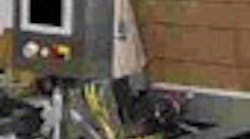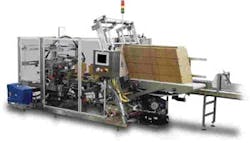This is Part II of a 2-part series. To read Part I, visit Domino Theory.
By Rich Merrit
ISA-88 is moving into discrete automation, too. John Parraga of Rockwell Automation used ISA-88 to automate an anodizing application (Figure 4) that involved robots, robot controllers, cranes, processing tanks and part ID tags. The control portion involves regulatory control, monitoring, interlocking, exception handling and repetitive discrete managed as sequences.
We used Rockwell Automations FactoryTalk Batch to define the system, says Parraga. First, we used the Equipment Editor to define what the plant equipment is capable of doing. Then, we used the Recipe Editor to define the procedures that coordinate the equipment. If the equipment isnt capable of performing the function, the Recipe Editor wont permit it.
FactoryTalk Batch provides sequencing instructions as well as equipment arbitration needed to carry out tasks, and then downloads commands to the controller or to an operator to perform a task manually.
Parraga says Rockwell Automation is using the ISA-88-based FactoryTalk in several other non-batch applications. In one application involving manual assembly of high-reliability military batteries, we use ISA-88 to define every step in the process, he says. The system tells the operator exactly what to do, checks quality measurements, and logs everything.
Figure 4: ISA-88 Controls Robots
This isnt your fathers ISA-88 any more. These robots take directions from ISA-88 procedures.
Hes also involved in a brewery routing application, which has many storage tanks and many filling stations. Connecting these is usually a job for PLCs, written in relay ladder logic. Parraga is using ISA standard concepts to determine routing instructions involving tanks, valves, pumps and filling stations. ISA-88 organizational concepts help determine what has to be done to get beer from any tank to any filling station.
Applying ISA-88 design principles in non-traditional applications is beneficial to a wide range of industries, says Parraga.
Process Meets Packaging
Dave Chappell is a very busy guy. Not only does he work as a process control consulting engineer by day, he serves on the committee that wrote TR 88-95.01, and he serves on the committee that wrote ISA Technical Report TR88.00.02, Machine and Unit States.
TR88.00.02, just published on July 18, 2008, marries ISA-88 to packaging applications. It is a joint effort of ISA, OMAC and the PackML organizations. We started working with PackML when we realized that we were both working toward the same goal of standardizing packaging operations, says Chappell. We were working on device descriptions and they were working on how to define recipes, and we both realized that a version of ISA-88 was the perfect solution.
Recipes for packaging? But thats a discrete automation application! As it turns out, most packaging lines follow a recipe of sorts, which defines the sequences of operations. The recipe can run continuously, or suddenly change for a different product coming down the line. Then, all the packaging equipment has to be reconfigured to handle the product change. ISA-88 allows all this information to be defined in a recipe.
Chappell says the next installment of ISA-88Part 5will address modular automation, such as packaging. It will define equipment control (not recipe control), which firmly moves ISA-88 into the discrete automation bailiwick.
Joe Faust, engineering manager at Douglas Machine in Alexandria, MN, says he has already been using the concepts of Part 5. We achieved a significant reduction in the amount of time it took to deliver a new machine program application, he says. As an early adopter, they spent considerable time and effort in developing the libraries of automation components they needed to support their designs. But it was worth it, Faust says, because it works across their entire product line.
Douglas Machine manufactures case/tray packers, shrink-wrap systems, and similar packaging systems for the food and beverage industries. The Axiom case/tray packer, Figure 5, handles up to 45 cases or trays per minute, and is controlled by an Allen-Bradley PLC.
Figure 5: Packaging with ISA-88
Douglas Machine uses ISA-88 to define packaging sequences in its Axiom packaging machine. Many of the same ISA-88 libraries apply to other machines they make, thus reducing application development time.
The long term goal is to have automation equipment providers supply these libraries based on Part 5, says Chappell. This can reduce the custom code needed in a packaging line application by providing interoperability across different equipment platforms, such as when Siemens and Rockwell and B&R systems are being used together on a packaging line.
This sounds very much like the effort that went into making vendors supply Device Descriptions or EDDL information for fieldbus systems. Chappell realizes that vendors will never supply libraries until big users, like Procter & Gamble, start specifying that all equipment must conform to Part 5 and the vendors have to supply the libraries. Then they will all jump into line, because their sales will be affected.
The marriage of batch and continuous control will have its honeymoon in the process industries, but you can be assured that ISA-88 and 95 will be taking side trips to the world of discrete manufacturing as well.
Latest from Safety Instrumented Systems

Leaders relevant to this article:





